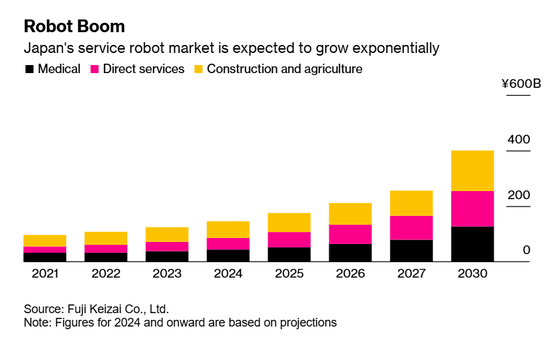Japan's service robot market is predicted to triple to 400 billion yen in five years, due to low birthrate, aging population and labor shortages

In Japan, the workforce is shrinking due to a declining birthrate and aging population, and labor shortages. To compensate for this, restaurants such as Gusto are now using cat-shaped food delivery robots to deliver food. Demand for such service robots is on the rise, and Bloomberg reported that the market is expected to triple in the next five years.
Thousands of Cat-Eared Robots Are Waiting Tables in Japan - Bloomberg

Japan's service robot market projected to triple in five years | TechCrunch
https://techcrunch.com/2025/03/09/japans-service-robot-market-projected-to-triple-in-five-years/
Research firm Fuji Keizai Group predicts that Japan's service robot market will grow to 400 billion yen by 2030, roughly three times its 2025 size.
The graph below summarizes the growth forecast for Japan's service robot market, with black representing demand for service robots in the medical field, pink representing the service field, and yellow representing the demand for service robots in the construction and agricultural fields.

Two factors are cited as driving the growth of the service robot market: a declining birthrate and aging population, and labor shortages. Recruit Works Institute predicts that Japan will face a labor shortage of 11 million people by 2040, and another government research institute estimates that by 2065, approximately 40% of Japan's population will be aged 65 or older.
One of the earliest adopters of service robots is the Skylark Group , one of Japan's largest restaurant chains. The Skylark Group's brands include Gusto, Bamiyan, Shabuyo, and Yumean, and it operates more than 2,000 restaurants nationwide, where cat-shaped food delivery robots are in charge of serving food. As of August 2023, Skylark has introduced 3,000 cat-shaped food delivery robots.
Skylark introduces 3,000 units - Introducing a cat-shaped food delivery robot (Nekorobo) - YouTube
Skylark employs more than 4,000 employees aged 65 or older, up more than 76% from approximately 2,270 in 2020. The proportion of foreign part-time employees is 3.3%, also up from 2.6% in 2020.
In addition, the proportion of labor costs to Skylark's total sales was 40.2% as of 2021, but will fall to 32.6% in 2024. According to Bloomberg, the introduction of the cat-shaped food delivery robot has enabled Skylark to save approximately 5 billion yen in labor costs per year.
Related Posts:







